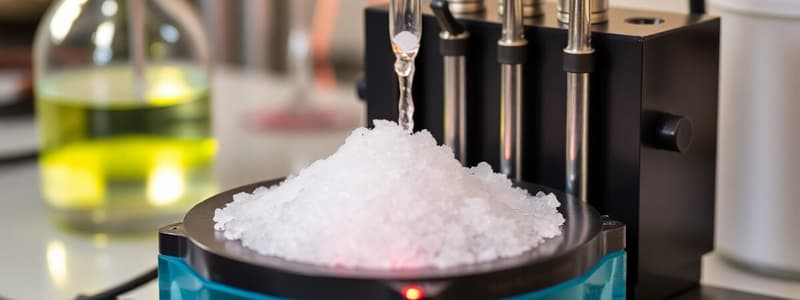Podcast
Questions and Answers
What role does the iron screen play in the Down Cell?
What role does the iron screen play in the Down Cell?
- It increases the melting point of the molten salt mixture.
- It separates the anode and cathode to prevent direct reactions. (correct)
- It acts as a catalyst for the reduction reaction.
- It collects the chlorine gas released at the anode.
Which statement about the cathode reaction in the Down Cell is accurate?
Which statement about the cathode reaction in the Down Cell is accurate?
- Sodium ions lose electrons to form sodium metal.
- Chloride ions are produced at the cathode during reduction.
- Sodium ions gain electrons to form sodium metal. (correct)
- Chlorine gas is formed at the cathode.
What effect does adding a mixture of NaCl and CaCl₂ have on the melting point during the sodium extraction process?
What effect does adding a mixture of NaCl and CaCl₂ have on the melting point during the sodium extraction process?
- It eliminates the need for an electric current.
- It allows sodium ions to remain solid during electrolysis.
- It lowers the melting point to 600°C. (correct)
- It raises the melting point to 801°C.
Which of the following accurately describes the anode reaction in the Down Cell?
Which of the following accurately describes the anode reaction in the Down Cell?
Identify the main product formed at the cathode during the electrolysis of NaCl.
Identify the main product formed at the cathode during the electrolysis of NaCl.
Flashcards are hidden until you start studying
Study Notes
Down Cell
- The Down Cell is an electrolytic cell used to produce sodium metal.
- A cylindrical container, with a graphite anode and a steel cathode immersed in molten sodium chloride, houses the process.
- The melting point of NaCl is 801°C, but adding a mixture of one mole of NaCl and three moles of CaCl₂ lowers it to 600°C.
- An electric current is passed through the molten salt, forcing positively charged sodium ions (Na+) towards the negatively charged cathode.
- Sodium ions gain an electron at the cathode, becoming sodium atoms (Na) in a reduction reaction.
- Chlorine gas is released at the anode (oxidation).
- An iron screen separates the anode and cathode to prevent direct reaction between them.
- The overall reaction is 2NaCl(l) → 2Na(l) + Cl₂(g).
Half-Cell Reactions
- At the cathode (reduction): Na⁺(l) + e⁻ → Na(l)
- At the anode (oxidation): 2Cl⁻(l) → Cl₂(g) + 2e⁻
Components
- Molten NaCl: The electrolyte where the reaction occurs.
- Graphite Anode: The electrode where oxidation occurs.
- Cylindrical Steel Cathode: The electrode where reduction occurs.
- Iron Screen: Separates the anode and cathode, minimizing unwanted reactions.
- Cl₂(g): Chlorine gas, a byproduct of the process.
- Na(l): Molten sodium metal, the main product.
Studying That Suits You
Use AI to generate personalized quizzes and flashcards to suit your learning preferences.




